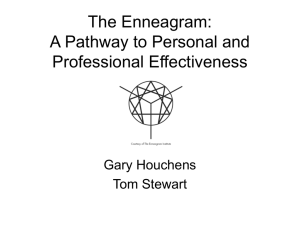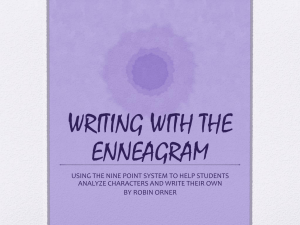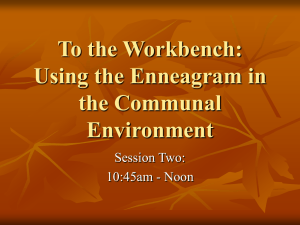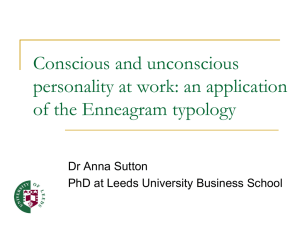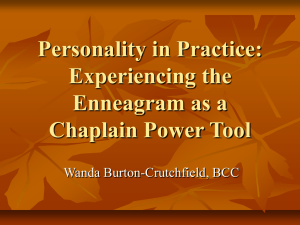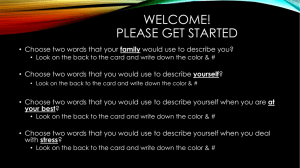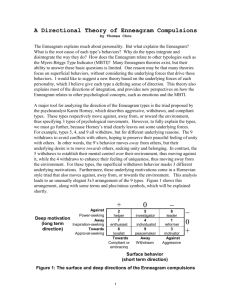The Enneagram
advertisement
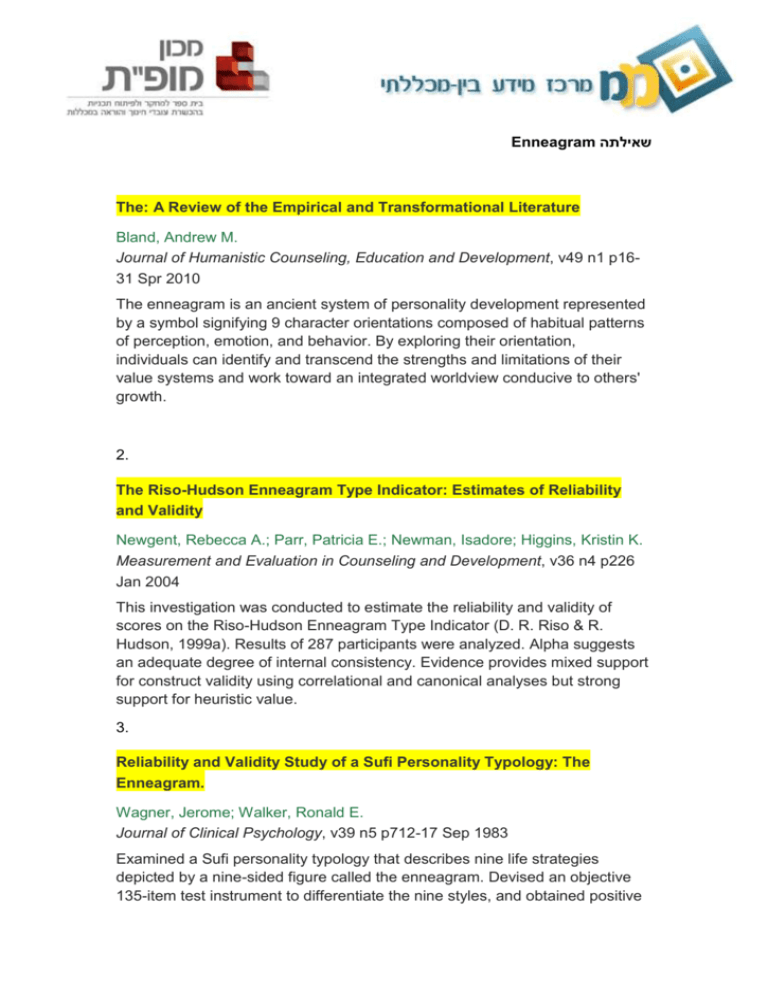
Enneagram שאילתה The: A Review of the Empirical and Transformational Literature Bland, Andrew M. Journal of Humanistic Counseling, Education and Development, v49 n1 p1631 Spr 2010 The enneagram is an ancient system of personality development represented by a symbol signifying 9 character orientations composed of habitual patterns of perception, emotion, and behavior. By exploring their orientation, individuals can identify and transcend the strengths and limitations of their value systems and work toward an integrated worldview conducive to others' growth. 2. The Riso-Hudson Enneagram Type Indicator: Estimates of Reliability and Validity Newgent, Rebecca A.; Parr, Patricia E.; Newman, Isadore; Higgins, Kristin K. Measurement and Evaluation in Counseling and Development, v36 n4 p226 Jan 2004 This investigation was conducted to estimate the reliability and validity of scores on the Riso-Hudson Enneagram Type Indicator (D. R. Riso & R. Hudson, 1999a). Results of 287 participants were analyzed. Alpha suggests an adequate degree of internal consistency. Evidence provides mixed support for construct validity using correlational and canonical analyses but strong support for heuristic value. 3. Reliability and Validity Study of a Sufi Personality Typology: The Enneagram. Wagner, Jerome; Walker, Ronald E. Journal of Clinical Psychology, v39 n5 p712-17 Sep 1983 Examined a Sufi personality typology that describes nine life strategies depicted by a nine-sided figure called the enneagram. Devised an objective 135-item test instrument to differentiate the nine styles, and obtained positive results. Enneagram typology may have diagnostic, prognostic, and heuristic value for studying personality structure and dynamics. 4. Using the Enneagram for Client Insight and Transformation: A Type Eight Illustration Tapp, Karen; Engebretson, Ken Journal of Creativity in Mental Health, v5 n1 p65-72 2010 The purpose of this article is to demonstrate how mental health practitioners can use the Enneagram's system of human personality development as a source of insight and a tool for personality transformation. The article provides an introduction to the Enneagram and its orientation to personality types and defines a linear process of how to use the Enneagram with clients. Mental health practitioners can use the Enneagram to help clients develop a deeper understanding of their personality styles and those of others to move forward with needed cognitive and behavioral changes, thereby effectuating productive relational change. 5. Developmental Relational Counseling: A Model for Self-Understanding in Relation to Others Duffey, Thelma; Haberstroh, Shane Journal of Creativity in Mental Health, v7 n3 p263-271 2012 Developmental relational counseling (DRC) is an integrative framework designed to help clients develop personal awareness and relational functioning and conceptualize personal growth. DRC emerged from both authors' clinical work and was significantly influenced by relational-cultural theory and guided by the Enneagram personality typology and cognitive and narrative therapies. DRC provides a roadmap for understanding the dynamics of personal awareness and relational functioning. 6. Synthesizing the Enneagram through Music Louden-Gerber, Gwen; Duffey, Thelma Journal of Creativity in Mental Health, v3 n3 p319-329 Oct 2008 This article describes a creative intervention used in an independent study course which focused on Enneagram studies. In addition to extensive reading, writing, discussion, and reflection at weekly meetings, one assignment for the course involved the compilation of songs that depict the core motivations, fears, and desires for each type. Utilizing contemporary songs to describe Enneagram type presentation provides students with an opportunity to focus on each type's core traits and challenges. Undergoing the process of song selection and elimination in and of itself tests the student's overarching understanding of the Enneagram typology. Creating a final product (i.e., a recorded selection of songs for each type) helps provide an additional medium from which to integrate this heavily nuanced material. Ultimately, each song seeks to create a personal voice in which individual type begins to surface in a more intimate manner. In this article, the authors provide a brief introduction to the "Enneagram personality," in addition to ways in which music can be used to facilitate an understanding of personality type within counselor education. The authors also provide an example of possible songs that can reflect each type's essential challenges, and possibilities for transformation. 7. The Soul of Teaching and Professional Learning: An Appreciative Inquiry into the Enneagram of Reflective Practice Luckcock, Tim Educational Action Research, v15 n1 p127-145 Mar 2007 This paper makes a contribution to the theory and practice of educational action research by introducing two theoretical and methodological resources as part of a personal review of sustained professional experience: "appreciative inquiry" and the "enneagram". It is more than a theoretical exercise, however, because it also constitutes an action-oriented reflection on the transitional nature of the author's professional situation, moving from work as a school-based primary school teacher and head teacher to work as a consultant. It is thus a distillation of past experience and a vision of how professional learning might be supported in the future. In the first part, appreciative inquiry is introduced as an associated form of action research methodology that follows four successive stages of discovery, dream, design and destiny around an affirmative topic choice. The author then explains his choice of the enneagram as a useful life-affirming tool for self-understanding in personal and professional development and how it might be used to stimulate reflexive awareness of the inner work of teaching. Thirdly, in the discovery stage, the author uses the enneagram to engage in a sequence of nine short mediations that seek to appreciate the positive core of teaching from the inside and celebrate the intimate experience of teaching according to nine distinct modes of consciousness. Fourthly, the author builds on the range of teaching strengths revealed by the enneagram by engaging in the dream stage of appreciative inquiry that evokes an imaginative envisioning of the kind of reflective practice the world is calling for from teachers. Finally, the author concludes by looking ahead to the design and destiny stages, reflecting on the need to explore the implications of the inquiry for systematic forms of practitioner research and appropriate kinds of tutorial support for professional learning. 8. Discovering the Enneagram. Cusack, Ginny Montessori Life, v8 n4 p34-35 Fall 1996 Presents the enneagram as a tool to identify one's personality type, leading to increased self-understanding and the ability to communicate with others. Describes staff inservice sessions for faculty and administration to identify personality type, discuss "hot buttons and openers," and elaborate on implications for work relationships. Discusses other uses, including teacher training, parent education, and middle-school education. 9. "BUT IS IT REAL?" A REVIEW OF RESEARCH ON THE ENNEAGRAM. Authors: Sutton, Anna Source: Enneagram Journal. Jul2012, Vol. 5 Issue 1, p5-19. 15p. 1 Chart. Document Type: Article Subject Terms: *ENNEAGRAM *JUSTIFICATION (Theory of knowledge) *HERMENEUTICS *INTERPRETATION (Philosophy) *POSITIVISM Abstract: The article reviews three studies on the enneagram, a nine-sided figure. It cites two reasons for why solid research on the subject is important which are to help to justify the use of the diagram and to prove that believers in the figure do not lose its really in idiosyncratic interpretations or conjecture. It presents a summary of the enneagram type scores on five traits such as extraversion, agreeableness and conscientiousness. 10. THE ENNEAGRAM AND STYLES Of PROBLEM-SOLVING. Authors: Nathans, Hannah Van der Meer, Han Source: Enneagram Journal. Jul2009, Vol. 2 Issue 1, p62-80. 19p. 9 Charts, 5 Graphs. Document Type: Article Subject Terms: *ENNEAGRAM *TYPOLOGY (Psychology) *PROBLEM solving *CONFLICT management *CHARACTERS & characteristics *PERSONALITY Abstract: The article presents a study which proves the accuracy of general references to the creative problem solving styles of the Enneagram types found in its most authoritative descriptions. The researchers explore the validity of the descriptions by the use of the Kirton Adaptation-Innovation (KAI) inventory on 124 persons with Enneagram types that are highly accurate. The results proved to be statistically significant in which most findings support the Enneagram descriptions. 11. ENEAGRAM STYLES AND MALADAPTIVE SCHEMAS: A RESEARCH INQUIRY. Authors: Wagner, Jerome Source: Enneagram Journal. Summer2008, Vol. 1 Issue 1, p52-64. 13p. 2 Charts. Document Type: Article Subject Terms: *SCHEMAS (Psychology) *ENNEAGRAM *COGNITIVE therapy *PERCEPTION testing *QUESTIONNAIRES *PSYCHOLOGY -- Research *METHODOLOGY NAICS/Industry Codes: 541720 Research and Development in the Social Sciences and Humanities Abstract: The article presents a study on the relationship between maladaptive schemas and Enneagram styles. Cognitive psychotherapy is an effective approach in assessing and changing how a person responds to the world, and its concept of maladaptive schemas occur when they distort reality. The different lifetraps that affect the perception of a person include abandonment, dependence and subjugation. The study used questionnaires to assess the correlation between Enneagram styles and the lifetraps. 12. CLIPPING THE WINGS OFF THE ENNEAGRAM; A STUDY IN PEOPLE'S PERCEPTIONS OF A NINEFOLD PERSONALITY TYPOLOGY. Authors: Edwards, Anthony C.1 Source: Social Behavior & Personality: an international journal. 1991, Vol. 19 Issue 1, p11-20. 10p. Document Type: Article Subject Terms: *ENNEAGRAM *PERSONALITY *TYPOLOGY (Psychology) *MENTAL health *PSYCHOLOGY *TEMPERAMENT NAICS/Industry Codes: 621330 Offices of Mental Health Practitioners (except Physicians) Abstract: The Enneagram is a personality typology staling that there are nine basic types of personality, each represented by a different number from one to nine. According to Riso (1987), in addition to being one basic type, people also have a wing of (i.e. possess traits of) one of the two types represented by a number adjacent to that representing the basic type. If Riso's argument is correct, people presented with brief descriptions of the nine types should perceive maximal similarity between types which are represented by adjacent numbers. This hypothesis was examined in the present study, but was not supported. 13. A COMPARISON OF THE NINE ENNEAGRAM PERSONALITY STYLES AND THEODORE MILLONS' EIGHT PERSONALITY PATTERNS. Authors: Wagner, Jerome Source: Enneagram Journal. Jul2012, Vol. 5 Issue 1, p21-34. 14p. 7 Graphs. Document Type: Article Subject Terms: *ENNEAGRAM *CORRELATION (Statistics) *PERSONALITY *TYPOLOGY (Psychology) People: MILLON, Theodore Abstract: The article discusses the correlations between the nine styles of the enneagram and the eight personality patterns proposed by personality theorist Theodore Millon. It mentions that a typology was devised by Millon to define eight personality patterns and the formulation of those matches the enneagram conception of the development of ego-fixations in different ways. It presents a study conducted by the author which found significant correlations between the two variables. 14. The couple's enneagram questionnaire (CEQ) Eckstein, Daniel . Family Journal 10.1 (Jan 2002): 101-108. Turn on hit highlighting for speaking browsers by selecting the Enter button Hide highlighting Abstract (summary) TranslateAbstract The enneagram is an ancient system designed to help a person better understand her or his primary needs and motivators. Eckstein shares a enneagram questionnaire to assist couples and families in understanding of both one's own plus one's partners and/or other family members' primary motivators. 15. The Enneagram: A Review of the Empirical and Transformational Literature Bland, Andrew M. . Journal of Humanistic Counseling, Education and Development 49.1: 16-31. American Counseling Association. 5999 Stevenson Avenue. (2010) Turn on hit highlighting for speaking browsers by selecting the Enter button Abstract (summary) TranslateAbstract The enneagram is an ancient system of personality development represented by a symbol signifying 9 character orientations composed of habitual patterns of perception, emotion, and behavior. By exploring their orientation, individuals can identify and transcend the strengths and limitations of their value systems and work toward an integrated worldview conducive to others' growth. 15. PERSONALITY DIFFERENTIATION OF IDENTICAL TWINS REARED TOGETHER. Authors: Maxon, Betsy Daniels, David N. Source: Enneagram Journal. Summer2008, Vol. 1 Issue 1, p65-76. 12p. 6 Diagrams, 1 Chart. Document Type: Article Subject Terms: *TWINS -- Psychology *ENNEAGRAM *PERSONALITY assessment *PSYCHOLOGY -- Research *METHODOLOGY *PERSONALITY development NAICS/Industry Codes: 541720 Research and Development in the Social Sciences and Humanities Abstract: The article presents a study on the use of Enneagram to identify the differences in the personalities of identical twins reared together. The Enneagram system views an individual based on personality types and how these interact with each other. The research methodology includes the use of the Essential Enneagram Test and interviews. The study found that the identical twins have different personalities, and suggested the genetic and environmental components in identifying personality.

